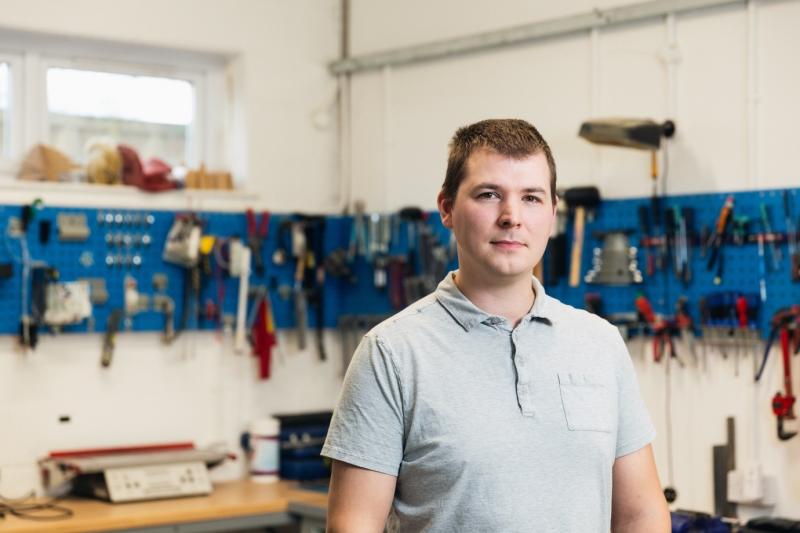
For Dean, job satisfaction comes from making something and seeing it being used. “You find a clever solution to a problem, and you get instant feedback from the students, like a big smile,” he says. “That’s really, really nice.”
Dean Hall was working as a building services engineer, designing electrical and mechanical ventilation systems, he realised his skill set would suit the Assistive Technology (AT) team.
“You need to be jack of all trades and master of none, so luckily my experience of engineering, motorcycle repairs, working as a sparky years ago, a bit of product design in my previous job all tied in,” he says.
So what is assistive technology?
Essentially assistive technology is using products or systems that help people with disabilities, restricted mobility or other impairments to perform functions that might otherwise be difficult or impossible. They can range from the simple to the wonderful – but every adaption makes a big difference. Things such as specially made holders for cups, joysticks or head switches to drive powered wheelchairs or even robotic arms to aid picking up items all aid the independence of disabled people.
Dean, an Assistive Technologist at Treloar’s is part of a team of six. He specialises in high end design and computer access.
“We work with the student and the occupational therapists to find solutions that will give students access to technology, onto a PC, or iPad” he says.
Adapting to Covid-19
During lockdown, the team were split in two to ensure services could be maintained, and would collect equipment and work on it remotely.
“Normally with a complicated technical problem, you’d have the student, carers and a couple of therapists in the room. We’d be trying to evaluate a joystick or a controller on a Zoom meeting, when normally you’d have a selection the student could try to see if it fits or works well.”
Not only did the team have to change practises, but they had to support our students in doing the same.
The impact of Assistive Technology
He recalls a student who had stopped using a PC.
“I was chatting away with him; found out he was a gamer. We came up with a bracket to hold an Xbox controller, and software that allowed me to programme it to work with a PC. I was able to turn that controller into a mouse with scroll, press and hold functions and things like that. The next day I had an email from him – he couldn’t write one before.”
One student had to take all his exams remotely but didn’t yet have the equipment he needed. So Dean and the team stepped in;
“He uses eye gaze to move a mouse, combined with a little joystick. We managed to source a monitor and a standalone PC, and with Computer Services we set him up in his own room, so he was able to take his exams from home. It meant we weren’t holding that student back from doing his exams this year.”
Another student, who had never had independent access before arriving at Treloar’s just before the pandemic, had very little controlled movement. With ten or eleven people involved, Dean says that eventually they came up with the idea of using the twist movement like a throttle on a bike.
“She’d been using a test mock-up, which was working OK, but she wanted some changes done. It would take her a while to write exactly what she wanted, so she asked whether there was any way she could see what might be done.”
With switches taking up to 20 hours to build, Dean needed a better plan. And in a Zoom meeting with the student, her family and carers, he screen shared 3D renders of how switches might work.
“It allowed her to visualise what she was getting and comment, before we spent a lot of time coming up with something that wasn’t necessarily right for her,” he says.
Thank you
We’re always amazed by what our Assistive Technology team can do. Could you imagine your wheelchair or car breaking down over night, meaning suddenly you couldn’t go about your day the next morning?
Many disabled people face that reality, but our expert team are on hand. With the kind support of donors and friends, some of the roles in our Assistive Technology team and the equipment they use every day are funded, so thanks to them we can ensure our students have their independence restored quickly without much disruption to their education and care.
Learn more about Assistive Technology on our YouTube channel.

